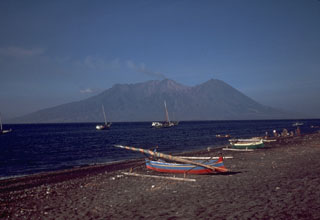Report on Sangeang Api (Indonesia) — March 2022
Bulletin of the Global Volcanism Network, vol. 47, no. 3 (March 2022)
Managing Editor: Edward Venzke.
Research and preparation by Paul Berger.
Sangeang Api (Indonesia) Small ash plume on 17 February 2022
Please cite this report as:
Global Volcanism Program, 2022. Report on Sangeang Api (Indonesia) (Venzke, E., ed.). Bulletin of the Global Volcanism Network, 47:3. Smithsonian Institution. https://doi.org/10.5479/si.GVP.BGVN202203-264050
Sangeang Api
Indonesia
8.2°S, 119.07°E; summit elev. 1912 m
All times are local (unless otherwise noted)
Sangeang Api is a complex volcano on the small island of Sangeang in the Lesser Sunda Islands, Indonesia, consisting of two volcanic cones. After a major explosion in May 2014, activity continued until November 2015, with thermal anomalies indicating possible lava dome growth or lava flows (BGVN 39:02 and 41:10). Another eruptive period during July 2017 into June 2020 included occasional weak ash explosions with ash plumes and emissions, hot material discharged from the summit crater, periods of numerous thermal anomalies, summit incandescence, and infrequent Strombolian activity (BGVN 42:09, 43:11, 44:05, 45:02, and 45:08). The volcano is monitored by Pusat Vulkanologi dan Mitigasi Bencana Geologi (PVMBG, or CVGHM), the Darwin Volcanic Ash Advisory Center (VAAC), and by various satellites.
The only documented activity during August 2020-February 2022 was an ash plume on 17 February 2022 reported by the Darwin VAAC that rose to an altitude of 4-4.9 km (~3 km above the summit) and drifted SW and WSW. During August 2020-February 2022, Sentinel-2 satellite images during this time were usually obscured by weather clouds, but no thermal signals or volcanic activity were observed when there were clear views. During May 2021 through February 2022, the MIROVA (Middle InfraRed Observation of Volcanic Activity) volcano hotspot detection system recorded ten scattered hotspots within 5 km of the summit; the cause of the weak anomalies is unknown.
Geological Summary. Sangeang Api volcano, one of the most active in the Lesser Sunda Islands, forms a small 13-km-wide island off the NE coast of Sumbawa Island. Two large trachybasaltic-to-tranchyandesitic volcanic cones, Doro Api and Doro Mantoi, were constructed in the center and on the eastern rim, respectively, of an older, largely obscured caldera. Flank vents occur on the south side of Doro Mantoi and near the northern coast. Intermittent eruptions have been recorded since 1512, most of them during in the 20th century.
Information Contacts: Pusat Vulkanologi dan Mitigasi Bencana Geologi (PVMBG, also known as Indonesian Center for Volcanology and Geological Hazard Mitigation, CVGHM), Jalan Diponegoro 57, Bandung 40122, Indonesia (URL: http://www.vsi.esdm.go.id/); Darwin Volcanic Ash Advisory Centre (VAAC), Bureau of Meteorology, Northern Territory Regional Office, PO Box 40050, Casuarina, NT 0811, Australia (URL: http://www.bom.gov.au/info/vaac/); MIROVA (Middle InfraRed Observation of Volcanic Activity), a collaborative project between the Universities of Turin and Florence (Italy) supported by the Centre for Volcanic Risk of the Italian Civil Protection Department (URL: http://www.mirovaweb.it/); Sentinel Hub Playground (URL: https://www.sentinel-hub.com/explore/sentinel-playground).

